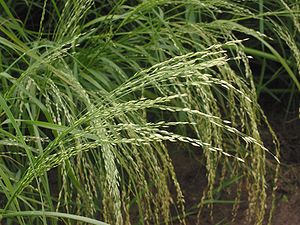Teff: Difference between revisions
m ISBN formatting &/or general fixes using AWB |
No edit summary |
||
| Line 50: | Line 50: | ||
[[de:Teff]] |
[[de:Teff]] |
||
[[fr:Teff]] |
[[fr:Teff]] |
||
[[fr:Mijo]] |
|||
[[he:טף]] |
[[he:טף]] |
||
[[lt:Posmilgė]] |
[[lt:Posmilgė]] |
||
Revision as of 00:22, 4 September 2006
| Teff | |
|---|---|

| |
| Scientific classification | |
| Kingdom: | |
| Division: | |
| Class: | |
| Order: | |
| Family: | |
| Subfamily: | |
| Genus: | |
| Species: | E. tef
|
| Binomial name | |
| Eragrostis tef (Zucc.) Trotter
| |
Teff or Tef (Eragrostis tef, Amharic ጤፍ ṭēff, Tigrinya ጣፍ ṭāff) is a species of lovegrass native to northeastern Africa. It has an attractive nutrition profile, being high in dietary fiber and iron and providing some protein and calcium. It is similar to millet and quinoa in cooking, but the seed is much smaller.
Teff is an important food grain in Ethiopia and Eritrea, where it is used to make injera, and more or less in India and Australia. Because of its small seeds (less than 1 mm diameter), one can hold enough to sow an entire field in one hand. This property makes teff particularly suited to a seminomadic lifestyle.
Common Names include Teff, Lovegrass, Annual Bunch Grass (English); Ṭeff/Ṭéff (Amharic, both representing the same sound); Ṭaffi/Xaffi (Oromo, both representing the same sound); Ṭaff (Tigrinya); Mil éthiopien (French). It is also written as Ttheff, Tteff, Thaff, Tcheff, Thaft, Tcheff (Anon. 1887). The word tef is connected by folk etymology to the EthioSemitic root "ṭff", which means "lost" (due to small size of the grain).
Teff is believed to have originated in Ethiopia between 4000 BCE and 1000 BCE. A 19th century identification of teff seeds from an ancient Egyptian site is highly doubtful; the seeds in question are more likely to be of E. aegyptiaca, a common wild grass in Egypt (Germer 1985).
It is adapted to environments ranging from drought stress to water logged soil conditions. Maximum teff production occurs at altitudes of 1800 to 2100 m, growing season rainfall of 450 to 550 mm, with a temperature range of 10 to 27 °C. Teff is day length sensitive and flowers best during 12 hours of daylight.
Cultivation and uses
Teff has been widely cultivated and used in the countries of Ethiopia, India and its colonies, and Australia. Teff produces up to two-thirds of the total food provision of Ethiopia. The grain has a high concentration of different nutrients. This grain has a very high calcium content, and contains high levels of phosphorus, iron, copper, aluminum, barium, and thiamin. A big advantage, according to Soil & Crop, is the fact that the iron from teff is easily absorbed by the body. It could thus enhance the performance of elite sportspeople. Teff is high in protein. It is considered to have an excellent amino acid composition (including all 8 essential amino acids for humans) and has lysine levels higher than wheat or barley. Because of this variety, it stimulates the flora of the large intestine. Teff is high in carbohydrates and fiber. It contains no gluten, so it is appropriate for those with gluten intolerance or Celiac disease.
Interest in new crops has led some Dutch farmers to cultivate teff, under the trade-marked name of Eragrain. In 2003, 150 farmers were growing teff. By the estimation of the company involved, Soil & Crop Improvement, in 2006 there could be 50 km² of this African grain in the Netherlands.
The Teff Company of Caldwell, Idaho has been growing teff and supplying the Ethio- and Eritrean-American communities for 25 years. They have demonstrated that teff is gluten-free, and are supplying the gluten-free market in the United States and Canada. The Teff Company has also been engaged in teff research with academic researchers, and has freely shared the information for the further development of teff (National Academy of Sciences). Teff has also been grown in limited quantities in South Dakota.
References and external links
- Germer, Renate (1985). Flora des pharaonischen Ägypten. Mainz: von Zabern. ISBN 3-8053-0620-2.
- National Academy of Sciences. Volume I: Grains. Washington, D.C.: National Academies Press, 1996. ISBN 0-309-04990-3
- Soil & Crop Improvement homepage
- The Teff Company homepage
- Purdue University Center for New Crops & Plant Products
- Teff Page at EthiopianRestaurant.com
- Dessie Summer Lovegrass Forage Variety
